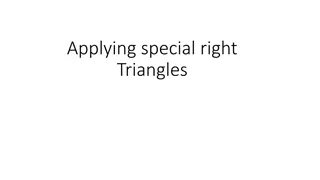Exploring Angles with Pasta Triangles
Engage students in a hands-on activity using pasta to explore angles in triangles. Through creating, measuring, and comparing pasta triangles, students will learn about congruence and similarity concepts. This interactive approach fosters understanding and critical thinking in geometry.
Download Presentation

Please find below an Image/Link to download the presentation.
The content on the website is provided AS IS for your information and personal use only. It may not be sold, licensed, or shared on other websites without obtaining consent from the author. Download presentation by click this link. If you encounter any issues during the download, it is possible that the publisher has removed the file from their server.
E N D
Presentation Transcript
How many angles? Explicit teaching
Visible learning Learning intentions To be able to determine if two triangles are congruent, similar, or neither based on the number of angles known. Success criteria I can determine if two triangles are congruent, similar, or neither. I can state whether two triangles will be similar based on the number and position of congruent angles.
Warm up Similar triangles?
Similar Triangles? Warm up 4
Launch Enough information?
Enough information? Launch 6
Explore Pasta angles
Pasta angles part 1 Explore One angle in common Create a triangle using three pieces of pasta and angle 30 . Tape your pasta triangle to a sheet of paper, so it won t move. 8
Pasta angles part 2 Explore One angle in common Measure with a ruler and record the length on the paper next to each side. Measure each angle (to the nearest 5 degrees) using a protractor and record the angle on the paper inside each vertex. 9
Pasta angles part 3 Explore One angle in common Compare triangles with group members, and answer each question: What is the same? What is different? Are any of your triangles congruent or similar? 10
Pasta angles part 4 Explore One included angle in common Create an included angle using the 30 angle, and two adjacent pieces of pasta measured and broken to be the same length. Place a third piece of pasta to connect the ends of each side to complete the triangle. Tape your pasta triangle to a sheet of paper, so it won t move. 11
Pasta angles part 5 Explore One included angle in common Measure with a ruler and record the length on the paper next to each side. Measure each angle (to the nearest 5 degrees) using a protractor and record the angle on the paper inside each vertex. 12
Pasta angles part 6 Explore One included angle in common Compare triangles with group members, and answer each question: What is the same? What is different? Are any of your triangles congruent or similar? 13
Pasta angles part 7 Explore Two angles in common Create a triangle using three pieces of pasta and angles 45 and 60 . Tape your pasta triangle to a sheet of paper, so it won t move. 14
Pasta angles part 8 Explore Two angles in common Measure with a ruler and record the length on the paper next to each side. Measure each angle (to the nearest 5 degrees) using a protractor and record the angle on the paper inside each vertex. 15
Pasta angles part 9 Explore Two angles in common Compare triangles with group members, and answer each question: What is the same? What is different? Are any of your triangles congruent or similar? 16
Summarise Pasta angles
Enough information? Summarise 18
Success criteria I can determine if two triangles are congruent, similar, or neither. I can state whether two triangles will be similar based on the number and position of congruent angles.























